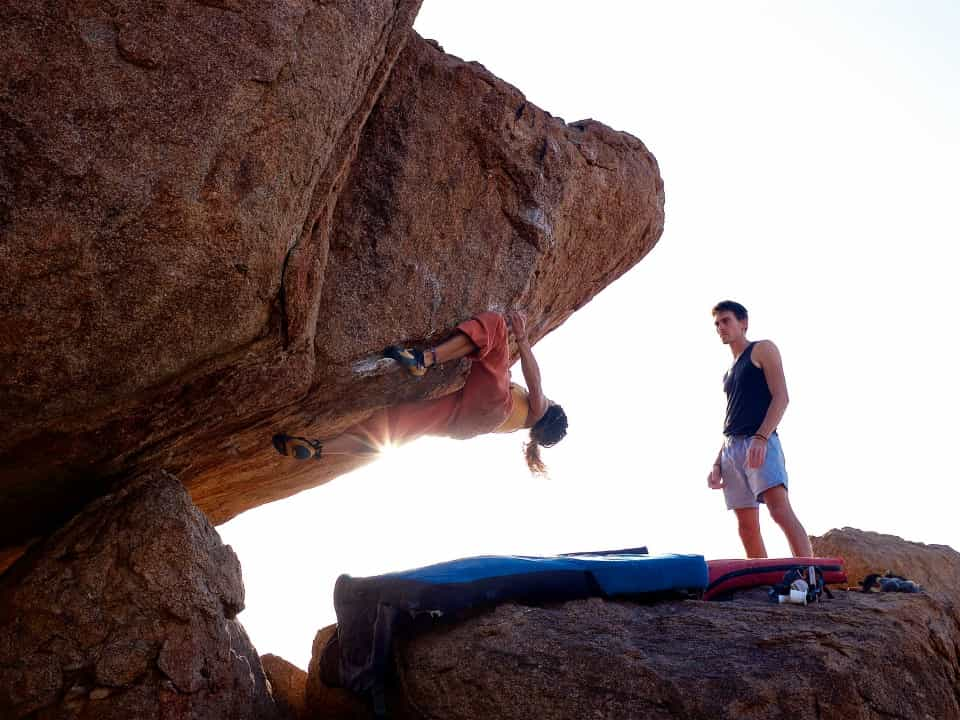Climbing in the Brecon Beacons
![]()
Wales is known for its climbing, and the Brecon Beacons (or Bannau Brycheiniog, to use its Welsh name) is no exception. The geology of this stunning national park is truly one of a kind (it’s also responsible for its vast network of caves), and a large part of the region is classified as a UNESCO-listed geopark. A significant swathe of the park sits on limestone, and this is where the majority of the best climbing is to be found – while it can be slippy and polished in places, it’s usually heavily featured and has many hand- and foot-holds.
This page introduces a few of the best places to go outdoor climbing and bouldering in the Brecon Beacons, as well as providing information about indoor climbing centres and practical tips to get started.
Outdoor climbing locations
![]()
Along with the nearby Wye Valley and Gower Peninsula, the Brecon Beacons has a range of great places to climb. Popular outdoor sport and trad climbing spots include:
Llangattock Escarpment
Once a huge quarry, the Llangattock Escarpment is located a short distance from Crickhowell in the east of the national park. Now reclaimed by nature, this place is a popular area for walking and climbing. The limestone crags stretch over an area of approximately three miles in length, and there are over 250 established routes – because of this, you can usually find a quiet spot.
The escarpment is popular with both advanced climbers and groups of beginners. For a comprehensive breakdown of the main routes, check out the South Wales Climbing Wiki, an invaluable resource for those visiting the crags.
Please note that a permit is required for the section of the escarpment that falls within the Craig-y-Cilau nature reserve.
Trefil Quarry
Located just outside Trefil, the highest village in Wales, Trefil Quarry is in the south of the Brecon Beacons, within easy reach of local towns like Merthyr Tydfil and Tredegar. The geology of this lesser-known climbing spot is fairly unusual, as these limestone crags contain the remains of an ancient carboniferous coral reef, making the spot popular with fossil hunters.
All of the routes here are concentrated around a single rock pillar, but there are seven distinct lines up. This small but technically engaging climbing spot will only be of interest to trad climbers, as there are no permanent holds for sport climbing.
Bouldering hotspots
Bouldering is a form of climbing done at a lower level without ropes (although you might want to bring a crash pad in case of falls). Compared to rope climbing, it's all about power and technique – perfect for building upper body strength. The Brecon Beacons is home to several places where you can learn and perfect this increasingly popular sport.
Dinas Rock
Dinas Rock, hidden away in a gorge near Pontneddfechan next to the Afon Hepste river, offers a taste of adventure for boulderers visiting the Brecon Beacons. There’s a car park just next to the gorge entrance, with amenities including several pubs and local buses around 15 minutes’ walk away in the village.
The rock itself provides a variety of challenges. Although other bouldering spots in South Wales are larger, Dinas Rock boasts a great range of problems, from beginner-friendly slabs to technical overhangs that will test experienced climbers. Parts of the rock are quite high, so rope climbing (sport and trad) and abseiling are also possible.
Cwmaman Boulders
Located just to the south of the national park on the outskirts of the village of Cwmaman, this boulder field has a wide variety of small sandstone boulders, so there are dozens of places where you can try out your best bouldering technique. The Cwmaman area also has a number of challenging sandstone crags where trad climbing is possible.
Indoor climbing centres
The Brecon Beacons and the surrounding area also have a number of places for indoor climbing. These are great options for visitors who are keen to try out the sport in a controlled environment or for when the weather makes outdoor climbing difficult.
Rock UK Summit Centre, Treharris (20 minutes’ drive south of the national park)
This large climbing complex is run by a not-for-profit organisation that is passionate about expanding access to outdoor activities. With over 120 different routes to try out, plus a kids’ area and café, Rock Summit UK is great for rope climbing (with an auto belay or not) and bouldering. Courses and taster sessions are run by the centre regularly, with updates posted on their website.
Llangorse Multi Activity Centre, near Brecon
Climbing is just one of the many sports on offer at Llangorse Multi Activity Centre, whose well-equipped wall near Brecon lies within the boundaries of the national park. Home to ‘The Cellar’, a purpose-built bouldering room, plus a range of roped routes, the activity centre offers courses, taster sessions and admission for unsupervised climbing for experienced climbers. Price and equipment hire details can be found on their website.
Dynamic Rock (south of the national park and north of Swansea)
Dynamic Rock is a friendly climbing wall centre located between the national park and the coast on the outskirts of Swansea. Popular with old and young climbers alike, this climbing centre welcomes both experienced and novice climbers and organises regular events such as outdoor climbing – great if you’ve caught the bug and want to try out your skills in a more challenging environment.
Next steps
-
Find a guide or instructor. Unless you’re an experienced climber, you’ll want to climb with guidance from a professional. The Bannau Brycheiniog National Park website has a list of tried-and-tested operators.
-
Be prepared by packing comfortable (but not baggy) clothing, suncream, snacks and a first aid kit (just in case).
-
Find a place to stay – whether you’re looking for simple tent pitches or self-catered accommodation with more amenities, there are lots of great places to stay in the Brecon Beacons National Park.
